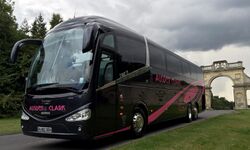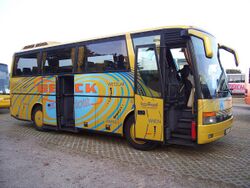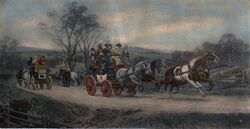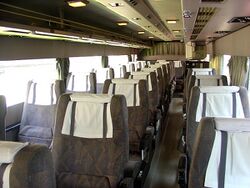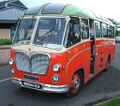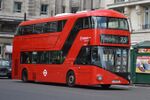Engineering:Coach (bus)
A coach (also known as a coach bus, motorcoach, or parlor coach) is a type of bus built for longer-distance service, in contrast to transit buses that are typically used within a single metropolitan region. Often used for touring, intercity, and international bus service, coaches are also used for private charter for various purposes. Coaches are also related and fall under a specific category/type of RVs.
Deriving the name from horse-drawn carriages and stagecoaches that carried passengers, luggage, and mail, modern motor coaches are almost always high-floor buses, with separate luggage hold mounted below the passenger compartment. In contrast to transit buses, motor coaches typically feature forward-facing seating, with no provision for standing. Other accommodations may include onboard restrooms, televisions, and overhead luggage space.
History
Background
Horse-drawn chariots and carriages ("coaches") were used by the wealthy and powerful where the roads were of a high enough standard from possibly 3000 BC. In Hungary, during the reign of King Matthias Corvinus in the 15th century, the wheelwrights of Kocs began to build a horse-drawn vehicle with steel-spring suspension. This "cart of Kocs" as the Hungarians called it (Hungarian: kocsi szekér) soon became popular all over Europe. The imperial post service employed the first horse-drawn mail coaches in Europe since Roman times in 1650, and as they started in the town of Kocs, the use of these mail coaches gave rise to the term "coach".[1] Stagecoaches (drawn by horses) were used for transport between cities from about 1500 in Great Britain until displaced by the arrival of the railways.[2]
One of the earliest motorized vehicles was the charabanc, which was used for short journeys and excursions until the early years of the 20th century.[citation needed] The first "motor coaches" were purchased by operators of those horse-drawn vehicles in the early 20th century[3] by operators such as Royal Blue Coach Services, who purchased their first charabanc in 1913[4] and were running 72 coaches by 1926.[5]
Features
As they hold passengers for significant periods of time on long journeys, coaches are designed for comfort. They can vary considerably in quality: some higher-specification coaches feature luxury seats, air conditioning, and refreshments, while others may only have the bare essentials such as storage and restrooms. Coaches typically have only a single, narrow door, but some can have two doors, as an increased loading time is acceptable due to infrequent stops. Some characteristics include:
- Comfortable seats that may include a folding table, armrests, and recliner. Comfort is considered to be an important feature in coaches.[6]
- Luggage racks above the seats where passengers can access their carry-on baggage during the journey
- Baggage holds, accessed from outside the vehicle, often under the main floor or at the rear, where passengers' luggage can be stowed away from the seating area
- Passenger service units, mounted overhead, on which personal reading lights and air conditioning ducts can be controlled and used by individual passengers with little disturbance to other passengers
- On-board restrooms fitted with chemical toilets, hand basins and hand sanitizer
- On some coaches, on-board entertainment including movies may be shown to passengers
- On-board refreshment service or vending machines
- Wheelchair accommodation, possibly including a wheelchair lift for access
- Curtains, useful on overnight services
- Onboard AC power and Wi-Fi access
Manufacture
Coaches, like buses, may be fully built by integrated manufacturers, or a separate chassis consisting of only an engine, wheels and basic frame may be delivered to a coachwork factory for a body to be added. A few coaches are built with monocoque bodies without a chassis frame. Integrated manufacturers (most of whom also supply chassis) include Autosan, Scania, Fuso, and Alexander Dennis. Major coachwork providers (some of whom can build their own chassis) include Van Hool, Neoplan, Marcopolo, Irizar, MCI, Prevost, Volvo and Designline.
Regulations
In some European countries following the 1958 type certification treaty, coach (that is vehicle of type M2 or M3) type certification is regulated by regulation number 107 from the UNECE. In the U.S., commercial drivers of motorcoaches are regulated by the Federal Motor Carrier Safety Administration (FMCSA).
Image gallery
Modern coaches
A representative selection of vehicles currently (or recently) in use in different parts of the world.
Vintage coaches
A selection of vehicles in use in different parts of the world in the past.
See also
- Intercity bus driver
- Intercity bus service
- Carriage
- Coach (carriage)
- Coach (rail)
- Coach transport in the United Kingdom
- Charabanc
- Double-decker bus
- Family Motor Coach Association
- List of buses
- Motor bus
- Multi-axle bus
- Sleeper bus
- Side loader bus
- Transit bus
References
- ↑ Mackay, James (1988). The Guinness Book of Stamps. Guinness Publishing LTD, Enfield, UK. p. 26.
- ↑ Dyos, H. J. & Aldcroft, D. H. (1969) British Transport, an economic survey Penguin Books, p. 225.
- ↑ W C Standerwick Ltd by Peter Gould
- ↑ Anderson & Frankis, p. 28–29.
- ↑ Anderson & Frankis, p. 41.
- ↑ Cooperative design, visualization, and engineering: third international... By Yuhua Luo, page 141
- Anderson, R. C. A. and Frankis, G. (1970). History of Royal Blue Express Services. David & Charles.
External links
 |
